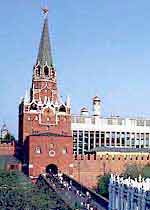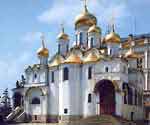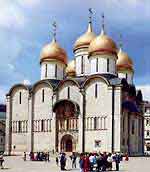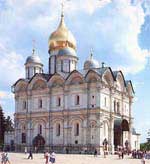
The Spasskaya Tower

The Troitskaya (Trinity)
Tower

The Borovitskaya Gate
Tower

Arsenal

The Cathedral of the Annunciation
|
| Kremlin |
The present-day Kremlin is a gem of Russian architecture which has been taking shape for centuries , an ensemble of wonderful places and cathedrals, a treasure house in which collection of values absolutely beyond all comparison are stored . "The Kremlin is a place of great historical remembrances ", this is what Nikolai Karamzin , a Russian historian , said . When looking at the magnificent panorama of the Kremlin , it is hard to believe that area was once covered with dence forests .
The first wooden Kremlin was built by order of Prince Yury Dolgoruky in 1156 . During the reign of Prince Dmity Donskoy whitestone walls were erected and since that time Moscow had been called "white-walled " . In 1485-1495 19 towers and toothed walls, resembling swallow tales, were built and clock were installed on some towers.
Today a clock on the Spasskaya Tower is preserved. It strikes every 15 minutes. At 6 a.m. and at midnight its chimes are broadcast over the radio.
All twenty Kremlin towers are very different from one another. The corner towers are round and those along the walls are rectangular. Eighteen towers are built into the fortress walls. One tur-ret, called the TSAKSKAYA (tsar's) Tower (situated opposite the cathedral of SL Vasily the Blessed), is placed on the wall. Still another one, the KUTAPYA Tower, stands separately in front of the TROITSKAYA Tower and is linked with it by a bridge .The heavy, squal Kutafya Tower was thus word "kutafya" used to mean "dumpy woman" or its name was derived from the word "kut", meaning "nook".
|
The Troitskaya (Trinity) Tower
Built in 1495, changed its name seweral times. Known originally as BOGOYAVLENSKAYA (Epiphany), it was later renamed Rizopolozhenskaya (Deposition of the Robe). Znamenskaya (after the Icon of the Mother Of God the high. meters 69.3 is tower the tower. (coach) karetnaya and sign).
|
The Borovitskaya Gate Tower
Was built to the design of Pietro Antonio Solary in 1490. In front of its gate there used to be a bridge over the Neglinnaya River. The tower has three progressively sinaller square tiers built on its massive rectangular lower part, distinguishing it from the other Kremlin towers.
Architects M. Choglokov, M. Renilzov and a number of others, erected the building of the Arsenal in-1702 - 1736. A year later the Arsenal was severely damaged during a great fire in the Kremlin. In 1786 - 1796 It was restored by engineer L Gerard under the supervision of architect Matvei Kazakov. In 1812 the building was once again damaged by a blow-up during the retreat of Napoleon's troops from Moscow. It was later restored by architects I. Mironovsky, A. Bakarev and others.
Along the building of the Arsenal, 875 trophy cannons captured by the Russian troops during the retreat of Napoleon's Grand Army in 1812 were placed in the mid-l9th century.
The Center of the Kremlin is Cathedral Square (Sobornaya) - the main and oldest square that has wit-nessed all most Important events in the history of tbe Russian state. Surrounding it are the Ivan the Great Bell Tower, the Palace of Facets, the Cathedrals of the Domition, the Annunciation and the Archangel Michael and a number of other monuments of Russian architecture.
|
The Cathedral of the Dormition
Was built in 1475 - 1479 by architect Aristotle Fioravanti. For centuries the cathe-dral has been regarded as the main church in Moscow. Russian metropolitans and patriarchs lie buried here.
|
|

The Cathedral of the
Dormition

The Cathedral of the
Archangel Mikhael

The Church of the Christ
Redeemer

Manezhnaya Square

Manezhnaya Square
|